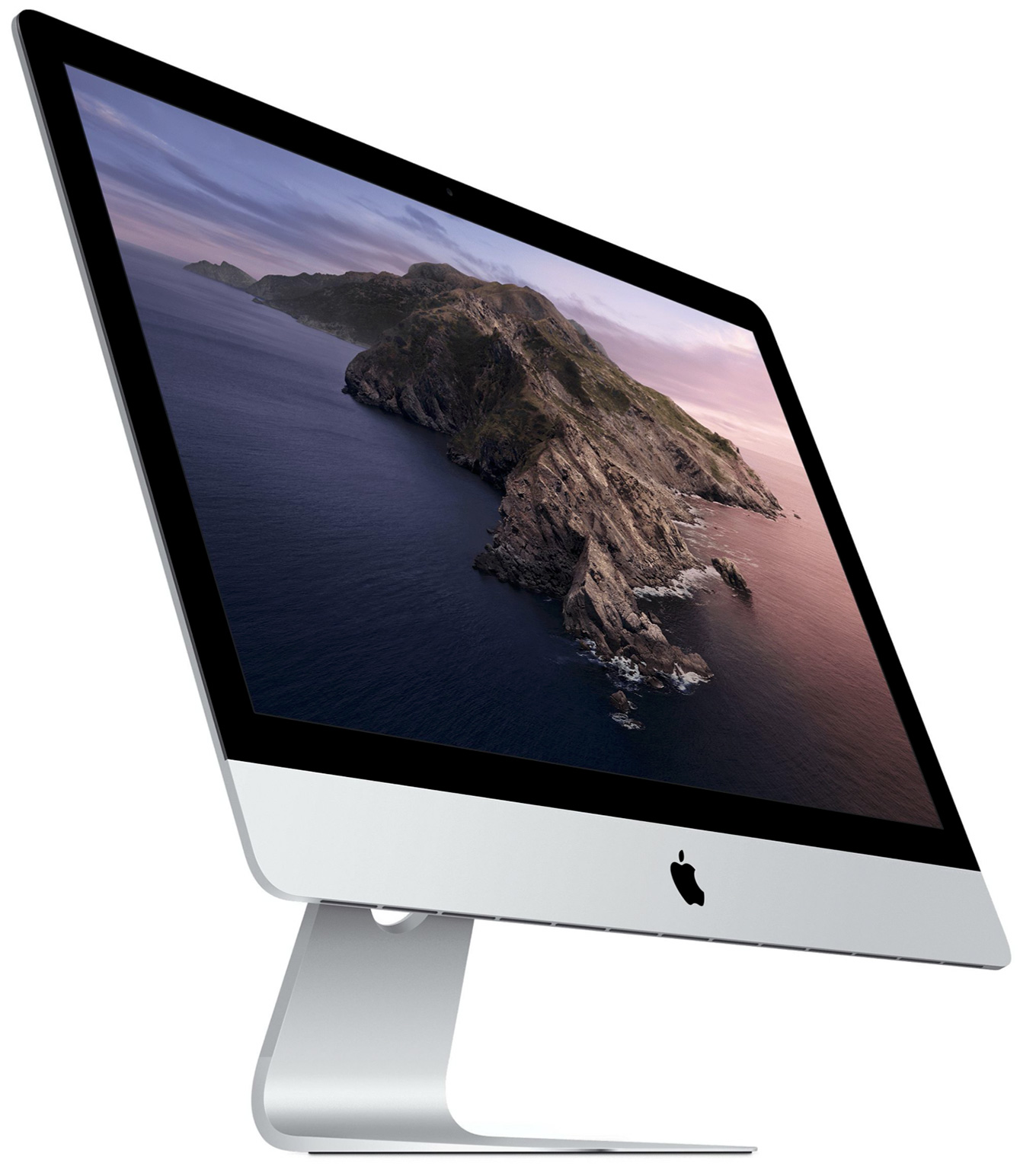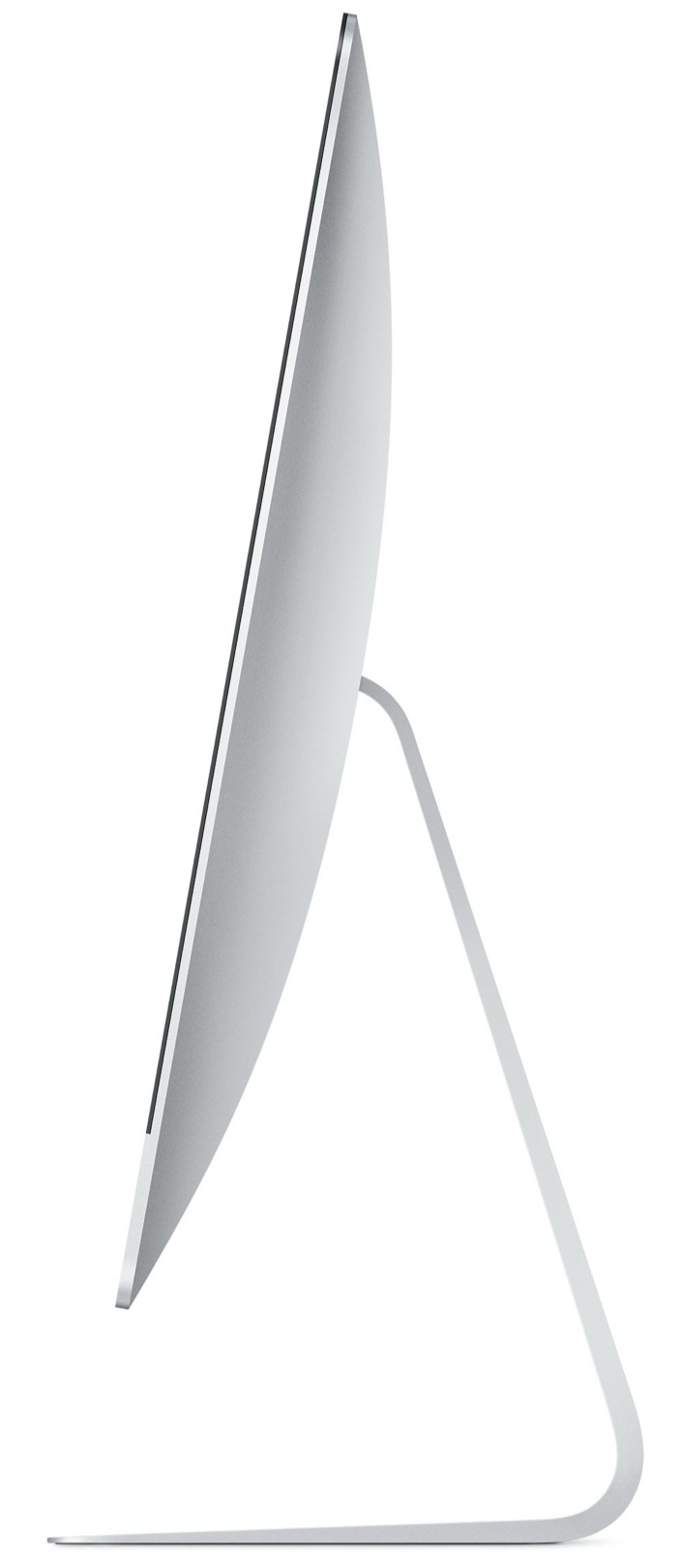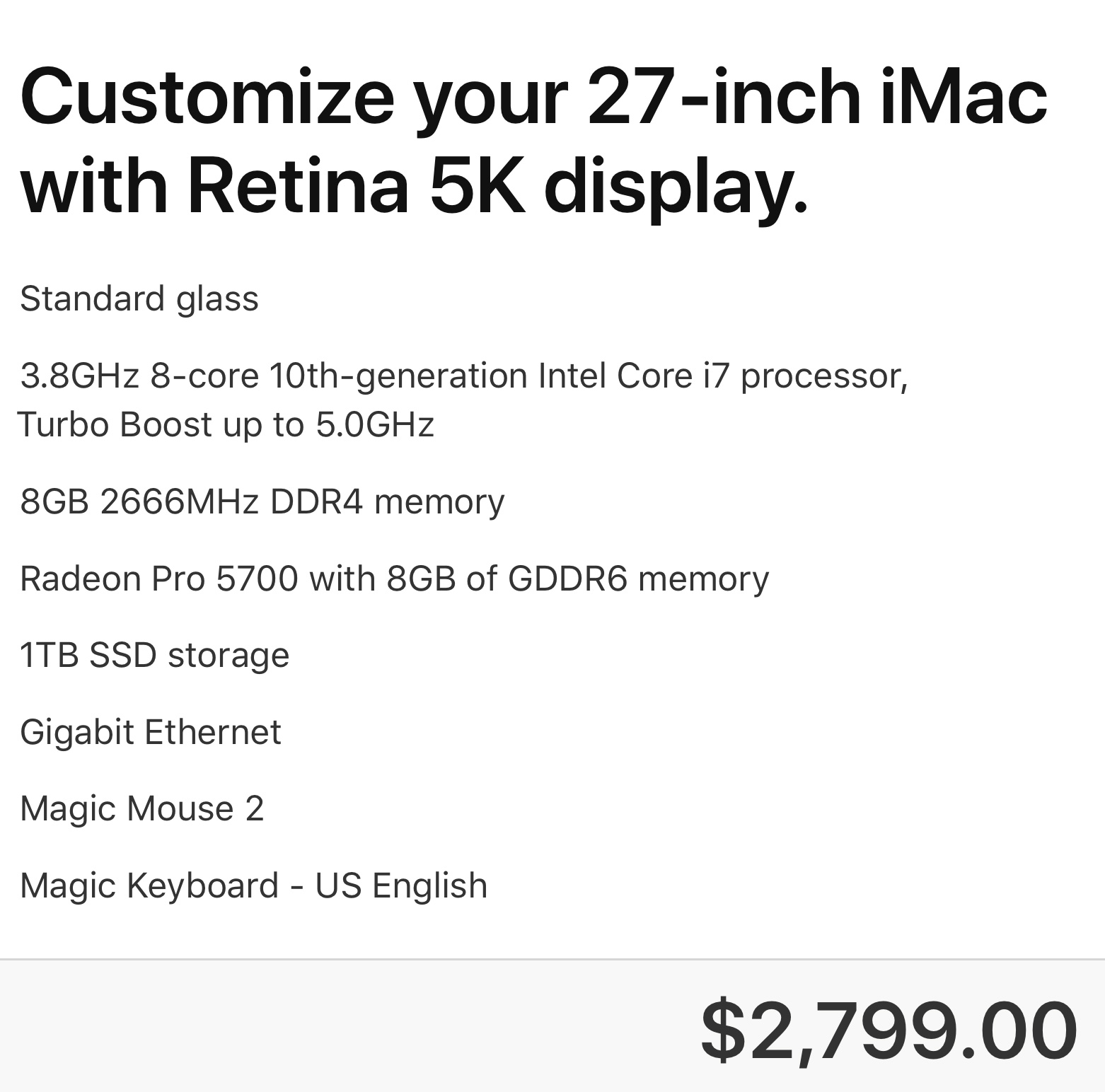 Last week, Apple updated both the 27″ iMac and the iMac Pro; though the iMac Pro got only a minor processor update. The question is, with the coming transition to Apple silicon, what should we do with these new systems?
Last week, Apple updated both the 27″ iMac and the iMac Pro; though the iMac Pro got only a minor processor update. The question is, with the coming transition to Apple silicon, what should we do with these new systems?
Initially, there was a big kerfuffle about these new Macs using the existing hardware design, as if the size of a computer’s bezels somehow affects its ability to process data. Design is valuable, but I don’t buy a Mac because of how it looks, I buy it for what it can do. Looks are good, performance is gooder.
I am not losing any sleep over the fact that the bezels on both my 2017 iMac and the new 2020 iMac are an inch wide. And the “chin” (lower silver part) of the system? That’s the best possible place to park all my yellow sticky notes.
NOTE: Apple updated the 27″ iMac, but not the 21″. The smaller system is very capable, but for video editing the larger screen, combined with the ability to upgrade RAM after the fact, make the 27″ iMac a better choice.

(All iMac images courtesy of Apple, Inc.)
So the first question we need to ask is: If I buy this iMac now, will it be obsolete in the future? Of course you know the answer: Absolutely yes. That’s been true of every computer made by every manufacturer for the last fifty years. The trend of continual hardware obsolescence will last long into the future.
A better question, though, is to ask: If I buy this Mac today, will I be able to use it for several years before it needs replacement? Here, again, the answer is: Yes. Every day I get emails from editors who are running their business on 2010, 2009, even 2008 Mac Pros and getting work done.
Macs are well-designed, well-built and any Mac you buy today will run for years. Period. You may not be able to fully upgrade it after a while, just as most 2010 Mac Pros are unable to run the latest version of the MacOS. However, you don’t need to run the latest OS to get productive work done. Even the oldest system is still fully capable of editing media on a daily basis.
You don’t need the latest gear to edit SD or HD video.
However, as we move into the world of HDR, 8K and 12K media and displays the size of moving vans, not to mention streaming multicam edits for these COVID times, you’ll need computers with more heft. 8K video pushes a lot of pixels. 12K media requires a mind-bending 75 MILLION pixels per frame!
NOTE: According to recent articles, the human eye is roughly equivalent to a frame size of 100 million pixels. So, we probably aren’t at the end of the “frame size race.”
So, why buy the latest 27″ iMac? According to an analysis published by AppleInsider.com, the iMac released by Apple last week has essentially the same power as the current Mac Pro, for about half the price.
In this new system, Apple boosted the CPU, GPU, RAM and storage. These systems are designed for power users who create stuff – from video to audio to code. If all you need is word processing, spreadsheets or browsing the web, these systems are overkill.
WHAT SHOULD YOU BUY?
To start, here’s Apple’s description of the latest systems.

Buying a new computer is always a balancing act between what you’d like and the money you have. Assuming you don’t have an unlimited budget, here’s how I suggest you spend it:
Processor. These iMacs offer i5, i7 and i9 processors. There is a BIG difference between an i5 and i9. I prefer an i7, simply for the price compared to an i9. Video editing does not require an i9. However, after using an i7 for years, then moving to an i5, I was surprised at the drop in interface responsiveness.
After a while, I stopped noticing. But, initially, the difference was dramatic. My next system will not have an i5 in it.
RAM. Apple RAM is desperately overpriced. There is no need to spend your dollars with Apple where, for half the price, or less, you can get far more RAM from OWC or Kingston or Crucial. It is easy to upgrade RAM in the 27″ iMac, unlike almost all other Apple devices. If this process makes you nervous, ask a friendly high school student to do it for you.
However, in your planning, I would aim for 32 GB of RAM. 16 GB is the minimum and there’s no advantage to getting more than 64 GB – except for bragging rights. Your editing will never need it.
GPU. The sweet spot for most GPUs is the middle choice. In this case, the Radeon Pro 5700 with 8 GB of VRAM. If you are doing effects heavy work, that you KNOW uses the GPU, spend the extra $200 for more VRAM. However, for most of us, save your money for more storage.
NOTE: Not all apps use the GPU for graphics work. If the apps you rely on use the CPU, then an i9 processor will be a better choice. I’d still go for the mid-range GPU, though, because Apple is really encouraging developers to leverage the GPU as much as possible when they upgrade their applications.
Storage. Regardless of how much storage you buy, it is never enough. You will ALWAYS need to purchase external storage. My current iMac has 2 TB of storage; however, I’m only using 400 GB of it. Why? Because I have 150 TB of external storage. I recommend 1 TB for internal storage. This provides plenty of space for your apps, plus lots of room for work files. The difference in price between 512GB and 1 TB is minor, while the performance is worth it. You can spend more, but, again, you’ll still need external storage. Save your dollars for a fast RAID or NVMe SSDs.
Ethernet. Unless you are hard-wired to a fast server, there’s no need for 10 Gb Ethernet. WiFi doesn’t provide that level of speed. However, if you, like me, are planning to upgrade your network to 10 Gb Ethernet, then this option makes sense. 10 Gb Ethernet will not make any difference in the speed with which you access the web.
Nano-Texture glass. Um, which is easier – spending $500 or turning your Mac so it doesn’t face any windows?
Mice. I am not a fan of Magic Mice. I prefer third-party mice with an Apple keyboard. And I’ve never seen the benefit of trackpads for video editing. But that’s just me.
PRICING

I started with the 27″ iMac with the i7 processor. (It’s the iMac on the far right of Apple’s iMac page.)
I kept the RAM at 8 GB so I can add 32 GB of third-party RAM (using 2 sticks) later. This would bring my total RAM to 40 GB, because the iMac holds up to 4 sticks of RAM.
NOTE: 32GB of additional RAM from OWC costs $119.76 vs. $600 from Apple.
I would add the mid-range GPU, along with 1 TB storage.
My final system is $2,799, plus $120 for OWC for a rough total of $2,920 (US).
WHAT ABOUT APPLE SILICON?
 (An illustration of an Apple silicon processor. Courtesy of Henriok / CC0.)
(An illustration of an Apple silicon processor. Courtesy of Henriok / CC0.)
I am very excited about the potential for Apple silicon. I think it will change our industry. But, it isn’t shipping yet. In fact, new iMac systems using Apple silicon have not yet started generating rumors. This means that high-end iMacs are not likely to be shipping for many, MANY months yet.
If you don’t need a Mac “right now,” think about this: Apple would not make the transition to Apple silicon in order to create systems with lower prices. That has never been their strategy. In every CPU transition – from 68K to PowerPC to Intel – performance has ALWAYS improved, while prices held steady.
NOTE: The original 128K Mac, released back in 1984, was priced at $2,499. And, yes, I bought one.
My expectation is that with these new systems prices will remain roughly the same, but performance will be SIGNIFICANTLY faster. But, Apple silicon is unknown technology. Apple’s keynote not withstanding, until Apple actually ships a computer we can use for every day work, as opposed to systems for developers to test products, we won’t actually know what the results of the move to Apple silicon will be.
So, if you are looking to make a safe choice, or you need a computer right now, the new 27″ iMac is an excellent choice. It runs all current Mac and, if needed, Windows software. It is proven technology in an established form-factor. You can be up and running 30 minutes after you open the box.
Plus, it has performance to burn.
128 Responses to Configure a 2020 27″ iMac for Video Editing – Should You Buy?
← Older Comments Newer Comments →-
 Robert Manciero says:
Robert Manciero says:
December 3, 2020 at 6:35 pm
-
 Larry says:
Larry says:
December 3, 2020 at 7:11 pm
-
 Robert Manciero says:
Robert Manciero says:
February 2, 2021 at 3:30 pm
-
 Larry says:
Larry says:
February 2, 2021 at 4:24 pm
-
 Lee says:
Lee says:
December 3, 2020 at 7:21 pm
-
 Larry says:
Larry says:
December 3, 2020 at 7:36 pm
-
 Lee says:
Lee says:
December 3, 2020 at 8:03 pm
-
 Larry says:
Larry says:
December 3, 2020 at 8:10 pm
-
 Lee says:
Lee says:
December 3, 2020 at 8:18 pm
-
 Brad Curran says:
Brad Curran says:
December 9, 2020 at 1:08 pm
-
 Larry says:
Larry says:
December 9, 2020 at 3:39 pm
-
 Jerry says:
Jerry says:
December 11, 2020 at 2:06 pm
-
 Larry says:
Larry says:
December 11, 2020 at 2:10 pm
-
 Jerry says:
Jerry says:
December 11, 2020 at 2:21 pm
-
 Larry says:
Larry says:
December 11, 2020 at 2:24 pm
-
 Jerry says:
Jerry says:
December 11, 2020 at 2:39 pm
-
 Larry says:
Larry says:
December 11, 2020 at 2:48 pm
-
 Jerry says:
Jerry says:
December 11, 2020 at 2:50 pm
-
 peterson tooke says:
peterson tooke says:
December 22, 2020 at 12:16 pm
-
 Larry says:
Larry says:
December 22, 2020 at 12:39 pm
-
 Rob says:
Rob says:
January 3, 2021 at 8:26 am
-
 Larry says:
Larry says:
January 3, 2021 at 9:44 am
-
 Rob says:
Rob says:
January 4, 2021 at 1:21 am
-
 Adam Simpson says:
Adam Simpson says:
January 12, 2021 at 3:29 pm
-
 Ja Franklin says:
Ja Franklin says:
January 16, 2021 at 8:40 pm
-
 Larry says:
Larry says:
January 17, 2021 at 8:56 am
-
 Kirk Taylor says:
Kirk Taylor says:
January 16, 2021 at 9:12 pm
-
 Larry says:
Larry says:
January 17, 2021 at 8:53 am
← Older Comments Newer Comments →Hi Larry,
I have always enjoyed your reviews and training videos. They are gold!
Have a question. I have a small production co. and we just bought the new Canon C300 mkiii. I edit on FCPx and have yet to edit any 4k but now we have the camera it could be a def possibility.
I went out and bought a Mac Pro 12 core with the new 5700 GFX card..refurbished of course. It is still sitting in the box because I just read all these great reviews on the new iMac and for me it’s about 4K cheaper. Now the question.
Will the iMac configured like your recommend, handle my needs. I do mostly 422 video and now would like to do some 4k work. I don’t see ever doing 8 tracks of 4k video at once.
Robert:
Given your description, the 2020 27″ iMac, configured to my recommendations, will more than meet your needs.
Larry
Update…just got my iMac configured as you recommend except went for the 16g video card and 32 ram from OWC.
Works fantastic!!! Thank you so much. I saved 1000s of $ by not buying the Mac Pro.
Performance is amazing.
Robert:
This is great news. Thanks for reporting back.
Happy to help.
Larry
Hi Larry!
I’m really hoping you can help me decide what mac is best for me. I love making videos for youtube. I like using premiere pro but I could be satisfied by just using final cut if the mac I buy would be cheeper in price. After doing some research it looks like either the 2020 27 inch imac or 2019 16 inch macbook pro would be my best options. It looks like the imac is cheaper if I don’t add anything to it but I’m not sure if that would cause the imac to be slow. Also can I use light editing in photoshop or would that slow these computers down too? I had a 2012 Macbook pro and looking to upgrade because using premiere on the 2012 computer really slowed the entire computer down and that is my main concern. I would really appreciate your advice! Thanks!
Lee:
Either of these systems would do a FINE! job with video editing. With both systems get at least 16 GB of RAM – more if you can afford it. If you need the most power, get the iMac. If you need portability, get the MacBook Pro.
Photoshop will run perfectly on either system.
larry
Great this was so helpful. Is there any other macs that are cheaper in price for what I’m looking to use my Mac for that you would recommend?
And for the 2020 27inch iMac do you think I need to customize it at all like your article or do you think if I just add 16 RAM that would be fine?
Lee:
You know your budget better than me. My article is designed to help you prioritize what gear will be best based on the budget you have available.
Any Mac can do what you need to do. Get the most recent Mac, say from 2018 or later, that you can afford. Spend money on RAM and GPU.
Larry
Thanks Larry! After months of trying to decide this has really narrowed it down for me!
Thanks for the helpful post. I mostly edit 4K XAVC footage and I’m hoping to forgo my current proxy workflow (on a mid-2015 imac) with a system that can easily playback, scrub 4K footage that’s fairly compressed (requiring more work for the system and why I use proxies). My question is: which graphics card do you think would be best to seamless edit? The sweet spot you mention here? THANK YOU!
Brad:
First, and this is an important question, why is proxy editing bad?
Given the race for every higher frame sizes – affordable cameras are now shooting 8K images – there will always be a format that pushes the limits of any computer. Hollywood for decades used work prints for all editing until it was time to create final effects and masters. Why is proxy editing different?
What you are buying with faster graphics cards is speed, not quality. For this reason, if you are editing 4K images – which I also suggest you optimize into ProRes 422 – a mid-range graphics card should be fine.
HOWEVER, the even bigger question is: Do you need to buy NOW? The new Apple silicon chips promise a major leap in performance. The high-performance chips should be shipping before summer next year. It might be better to continue working with the gear you have until the new chips are available.
All that being said, I think any currently shipping Mac desktop with a mid-range or above graphics card will handle your media.
Larry
Hi Larry, thanks for all the effort. Looking to wait for the new silicon chips, but need a system to work with now. What are your thoughts about using an external SSD with a 2019 mid level iMac 27 (the one I can get only has a Fusion drive) before the upgrade?
Thanks
Jerry:
Smile…. Oh, I don’t know. What do you think of the Ford F-150 pickup?
Until you give me a clue about what you want to do with this gear, it’s pretty darn hard to offer an opinion.
Larry
Majority of work is for YouTube. Skip the Ford, style Larry, style.
Jerry:
Key criteria for any hardware purchase are: the speed you need to get things done, the NLE you are using, the frame size you are working in, and the codecs you are using. The distribution format is trivial.
If you are at 4K and below, not emphasizing HDR and have reasonable deadlines, the 2019 27″ iMac is an excellent choice.
Larry
My question is working with a fusion drive. I have been using a Mackbook Pro with SSD drive, and never worried about tech, won’t have access to MacBook for next 6-8 months. Am I able to work off Fusion drive, not worried about deadlines. I am reading everywhere to avoid fusion drive, and need your opinion. Can I skip the SSD?
Sorry for the painful questions.
Using FCP.
Jerry:
There’s nothing wrong with a Fusion drive. I use one on a daily basis. Depending on the size of the internal drive, the SSD part of a Fusion drive is either 28 GB or 128 GB. (I forget). It seamlessly loads files you use more than others.
Personally, I’d suggest getting the Mac without the SSD. Then, if performance is not to your spec, add the SSD later. And there are some REALLY fast ones from Samsung and OWC that move data close to 2500 MB/sec, for just a few hundred dollars.
The iMac should be fine as is – assuming enough RAM and a mid-range GPU – add the SSD later.
Larry
Awesome. Thanks Larry.
Hi & thanks as always for your generous advice. I am in agreement on your recommended specs ( mostly Premiere here) save one question about your graphics card choice: May I ask why you choose the Radeon Pro 5700 (w 8GB) over the 5500 XT (w/8GB)? I have searched and found zero info comparing these… some negative info on the 5700 XT (16GB) but mostly just general hearsay. Would love to know more – Thank you!
Peterson:
The recommendation comes down to my focus for the article: maximizing performance while minimizing budget. ALL GPUs generate images with the same quality, the difference is the speed with which they do so. So, if time is more important than money, get the fastest GPU you can afford. If money is more important than time, get the less expensive one.
Given that, there is still a benefit to not buying the cheapest GPU, which is why I recommended the 5700.
Larry
What is your experience with rendering longer videos (like 2 hours+) and if the CPU is constant or if it will throttle after a longer load?
Rob:
This is a good question, but impossible to answer. Throttling is caused when heat levels for the CPU grow too high. This is primary a problem in portable devices – like laptops – because there isn’t a lot of space inside the chassis to move air to reduce heat.
In larger computers, like iMacs, there is much more space for fans, cooling and heat removal.
As well, throttling is also dependent upon the codecs you are using, much less so on the duration of the media. Some codecs are CPU intensive, others are GPU intensive and the cooling load varies.
Finally, the architecture of the Apple M1 chip vs. Intel chips also affect compression speed, heat generation and throttling.
The short answer, though, is that throttling should generally not be much of an issue for an iMac.
Larry
Hi Larry,
Thank you for your extensive answer. This is what I thought too. I will receive my iMac 2020 10-core today and I will put it too some tests against my Mac Pro (trashcan) but I am sure it wil be fine.
Rob
Larry Thanks so much for this concise article. I really appreciate your expertise and candor.
An Older iMac
Out of frustration I gave up editing. I literally edited my last piece 6 years ago. I think I am ready to get back into the game. My question is, am I going to have to spend on a new iMac to get back in or can I reconfigure my old iMac? (Retina 5K, 27-inch, Late 2014 / 4 GHz Quad-Core Intel Core i7 / 16 GB 1600 MHz DDR3 / AMD Radeon R9 M295X 4 GB)
Ja:
Don’t buy new gear. FIRST, figure out if you really WANT to get back into editing. Use your 2014 system to restart. If you like it, you can always buy new gear later. If you don’t, you haven’t spend thousands of dollars to realize that you should still don’t like editing.
There are limitations here. Your gear won’t run the latest versions, but, the versions it CAN run were state of the art when they were released. They will be fine for any HD editing you care to do.
Larry
Hi Larry,
Thanks for all your advice i value it highly.
Currently on a imac 27 – i5 (2015) 1tb fusion 32 gb ram. Just ordered a 2020 imac i7 with your recommendations. Just noticed that these new M1 mac mini are a game changer for video editing performance. I edit on FCPX mostly/ doing 4k on 1080 timelines and starting to learn davinci 17 and plan to take on bigger projects. Wonder if i should cancel my imac order to get the M1 mini for better performance? Dont want to be disappointed with performance issues or otherwise.
Thanks
Kirk:
You won’t be disappointed with the iMac’s performance, but…
If you need a system right now, the iMac is a great choice. Fast, powerful, compatible – everything you expect in a Mac.
But it is not the future. The future lies with Apple’s custom silicon. The Mac mini is Apple’s first effort – and it blew the doors open on what can be done with silicon today. The 2020 iMac is a better choice for editing than the Mac mini, but, the Apple silicon iMac will be the system of choice when it ships.
And there’s the rub. Apple won’t be shipping the new iMac for several months now. So you have choices to make:
1. If you need a new system right now, get the 2020 iMac.
2. If you need a new system right now, but don’t have the money, get the Mac mini with 16 GB of RAM and 1 TB of storage. But this will quickly get out-classed by new systems. Also, the Mac mini has no monitor or keyboard, which will increase the price.
3. If you can wait, get the Apple silicon iMac when it ships.
Given your description of what you are doing, any of these systems can meet your needs.
Larry